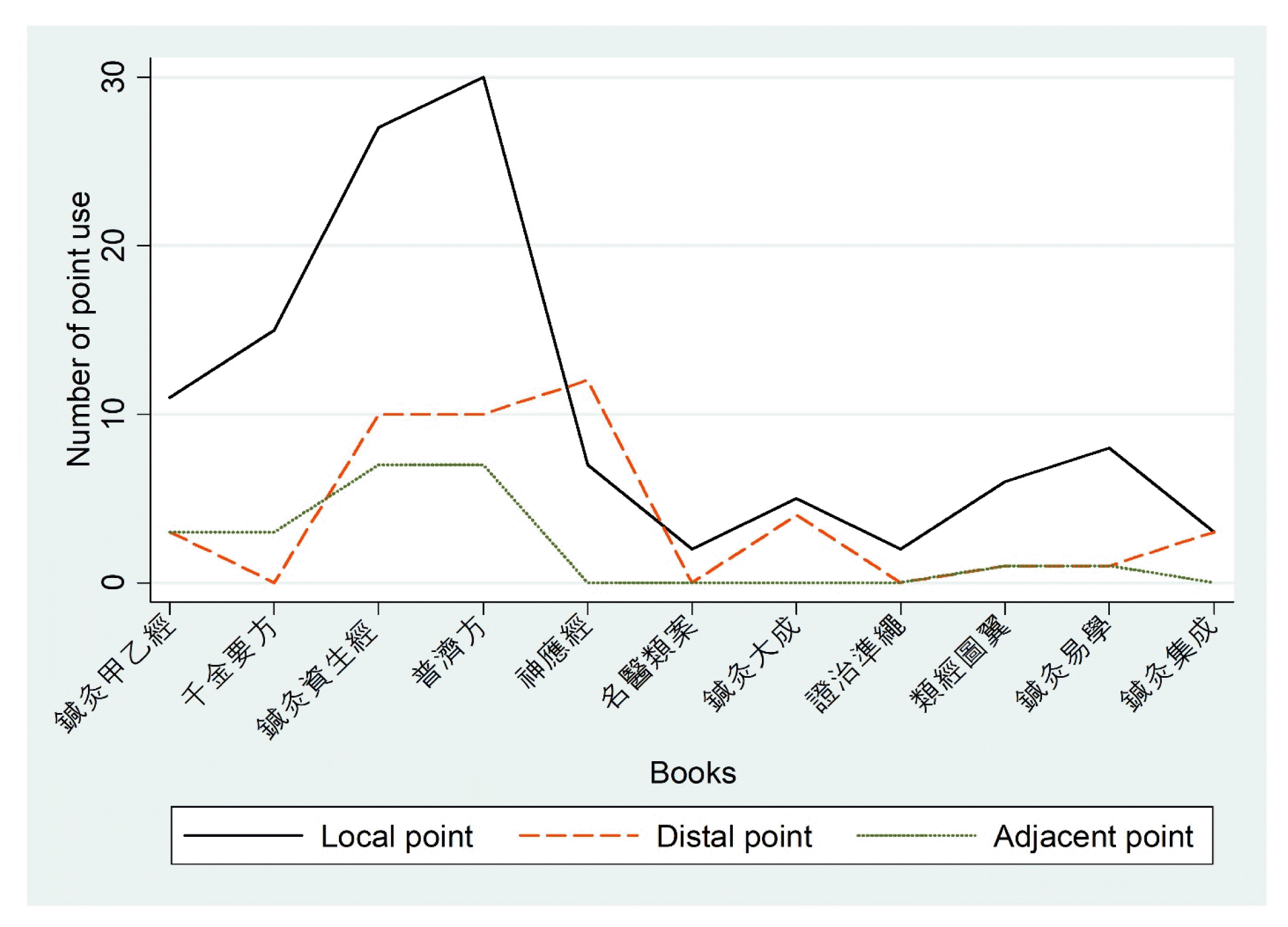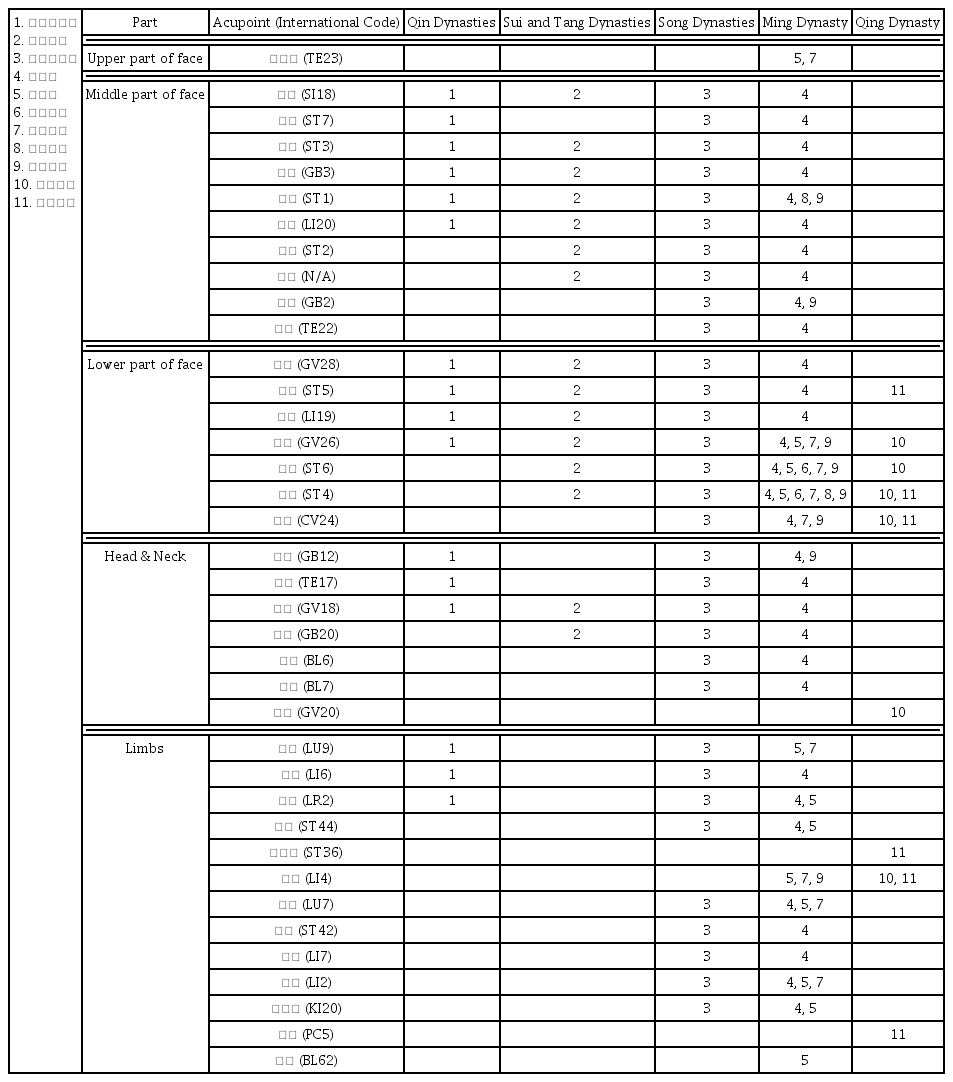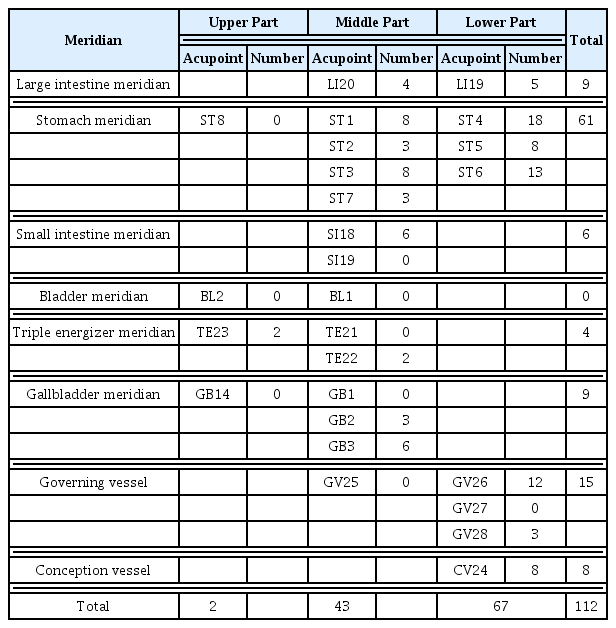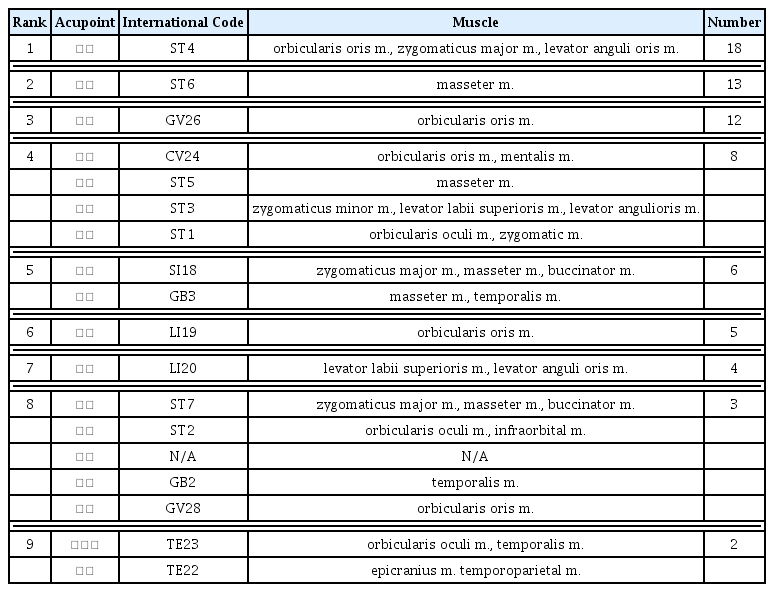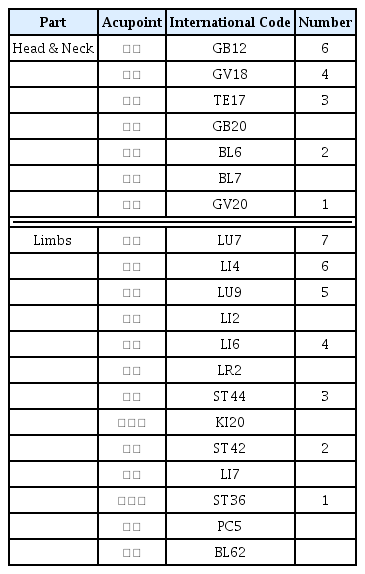References
1. Yoon H.C.. 2023;A study on the characteristics of patients with facial palsy treated with Korean medicine - Based on the Korean National Health Insurance statistical yearbook. J Korean Med 44(2):10–19.
http://dx.doi.org/10.13048/jkm.23013
.
2. Textbook compilation committee of acupuncture and moxibustion. 2016. Acupuncture and moxibustion medicine Paju: Jipmoondang.
3. Lee S.J., Kim H.J., Seo D.W., Sohn C.H., Lee J.H., Oh B.J., et al. 2012;Analysis of Clinical Outcome and Effectiveness of Steroid and Antiviral Treatment in Patients with Bell’s Palsy in the Emergency Department. JKSEM 23(4):531–536.
5. Lee S.B., Park Y.B., Kang S.K.. 1990;A Study on the Method of Acupuncture Point Prescription in the Symptomatic Treatment. J Acupunct Res 7(1):283–300.
6. Peter D., Al-Khafaji M., Baker K.. 2001. A Manual of acupuncture East Sussex, England: A Manual of Acupuncture Publications.
7. Oh S.J., Lee S.R.. 2005;Effects of Acupuncture at Right Nae-jong (ST44) on the Temperature and Humidity Changes of Sa-baek (ST2) Area. Korean J Acupunct 22(3):41–51.
8. Sun T.X., Feng S.W., Ren Y.L., Li P., Fan S.L.. 2016;Regularities of Acupoint Combinations for Facial Paralysis in Chinese Ancient Times Analyzed in Accordance with Modern Complex Network Community Framework Partition. Acupunct Res 41(3):265–269.
10.13702/j.1000-0607.2016.03.014.
9. Jeong H.I., Kim K.H., Oh Y.T., Choi Y.M., Song B.Y., Kim J.U., et al. 2018;Korean medicine for treating facial palsy - A literature review of case reports. J Pharmacopuncture 21(4):214–225.
10.3831/KPI.2018.21.025.
10. Huang W., Fu C., Wu T., Deng Y., Jiang W.. 2020;Rules of Acupoints in Treating Peripheral Facial Paralysis Based on Data Mining. Chin J Ethnomed Ethnopharm (Zhongguo Min Zu Min Jian Yi Yao) 29(21):1–5.
11. Peng R.C.. 1994. Zhen Jiu Chu Fang Daci Dian Beijing: Beijing Publishing House.
12. Wang D.S.. 1996. The abstract of Zhenjiu books and journals of China Beijing: Renmin weisheng chubanshe.
13. Yuan Y.X., Ren J.X., et al. 1996. Chinese-English Dictionary of Traditional Chinese Medicine (Han-Ying shuangjie Zhongyi da cidian) Beijing: Renmin weisheng chubanshe.
14. Seok J.H., Yoon J.H., Lee J.H., Hwang M.W., Cho Y.J., Kho B.H., et al. 2007;The upgrade of sasangin classification system by the morphologic study of head and face: Facial differences on sex and age. J of Sasang Constitutional Medicine 19(3):30–50.
15. Byun J.Y., Son I.C., Um T.S.. 1992;A bibliographical study about the blood characteristics of Joksamni and Kwanwon points. The J of Korean Acupuncture & Moxibustion Society 9(1):173–178.
16. Textbook compilation committee of acupuncture and moxibustion. 2014. Acupuncture and moxibustion medicine Seoul: Jipmoondang.
17. Lee D.K., Seo H.J., Na C.S.. 2000;Pain and Muscle lasticity for Deficiency-Excessiveness Discussed by the View of Oriental and Western Medicine. J Kor. AM – Meridian & Pointology Soc 17(1):141–156.
18. Kim Y.M., Baek Y.H., Lee J.D., Park D.S., Kim C.H., Koh H.K.. 2002;Clinical Studies on 11 Cases of Facial Nerve Palsy in Herpes Zoster Oticus. The J of Korean Acupuncture & Moxibustion Society 19(5):234–246.
19. Seo J.C., Kim S.Y., Seo Y.J., Park J.H., Lee Y.J., Ryu H.M., et al. 2016;The Effect of Korean Medical Treatments with Postural Yinyang Correction of Temporomandibular Joint on Bell’s Palsy. Korean J Acupunct 33(4):183–193.
https://doi.org/10.14406/acu.2016.021
.
20. Zhou H.X.. 1989;Clinical Analysis on 172 Cases with Facial Paralysis Treated by Acupuncture in Both Hands. Zhongguo zhen jiu (05):37–38.
10.13703/j.0255-2930.1989.05.026.
21. Ma Y.S.. 1991;Comparative Observation on Treatment of Joined-Puncture for 100 Cases of Peripheral Facial Neuritis. Zhongguo zhen jiu (02):23–24.
10.13703/j.0255-2930.1991.02018.
22. Ren L.J.. 1987;Clinical Observation on Treatment of Joined-Puncture for 400 Patients Suffering from Facial Paralysis. Zhongguo zhen jiu (03):13–14.
10.13703/j.0255-2930.1987.03.011.
23. Wang T.. 1992. Oidaibiyo Seoul: Daesung publisher. [No English title. Write it in native pronunciation.].
24. Xi F.Z.. 1989. XiFangZiMingTangJiuJing Shanghai: Shanghai traditional chinese medicine publishing house. [No English title. Write it in native pronunciation.].
25. He S.H.. 1985;Clinical Observation on 75 Cases of Facial Paralysis Treated by Acupuncture. Zhongguo zhen jiu (03):10–12.
10.13703/j.0255-2930.1985.03.00.
26. Wu J.W.. 1987;Clinical Observation on 220 Cases of Peripheral Facial Paralysis Treated by Acupuncture and Moxibustion on Facial Nerve. Zhongguo zhen jiu (03):19–20.
10.13703/j.0255-29301.987.03.015.
28. Zhang L.Z., Xu N.G.. 2017;Theoretical research on the theory of orofacial diseases can be treated with Hegu (LI4). CJTCMP 32(3):950–952.
30. Liu Q., Jia W., Wang H.T.. 2013;Wanghongjing zhuren yishi cong “yang ming zhu mian” lun zhi mianbu jibing de jingyan. CJGMCM 28(10):2009–2010.
10.3969/j.issn.1003-8914.2013.10.010. [No English title. Write it in native pronunciation.].
31. Zhang D., Wen B., Wei Z., Gao H., Peng Y., Meng J.. 1990;The comparison of changes of the facial temperature after acupuncturing point of hand and foot-yangming meridians by the thermography. Zhen Ci Yan Jiu 15(3):191–193.
10.13702/j.1000-0607.1990.03008.
32. Kim J.H., Kwon H.J., Song J.H., Choi D.Y., Lee S.H., Lee J.D.. 2008;A review of the anatomy of face for the clinical application of facial acupuncture. J of Korean Acupuncture & Moxibustion Society 25(3):221–228.
33. Xie W.Z., Shi Y.C.. 1996;De cang tou jia che zhiliao mianshenjing mabi. Nei Mongol J Tradit Chin Med (S1):57. 10.16040/j.cnki.cn15-1101.1996.s1.067. [No English title. Write it in native pronunciation.].
34. Wang Z.M., Hao Q.H.. 2001;Zhen ci de cang tou jia che xue wei zhu zhiliao miantan. China’s Naturopathy 9(2):12–13.
10.19621/j.cnki.11-3555/r.2001.02.010. [No English title. Write it in native pronunciation.].
35. Wang M.Q.. 1986;Zhen ci zhiliao mianshenjing mabi 100 li. Zhongguo zhen jiu (04):40. 10.13703.j.0255-2930.1986.04.026. [No English title. Write it in native pronunciation.].
36. Rink S., Bendella H., Akkin S.M., Manthou M., Grosheva M., Angelov D.N.. 2019;Experimental studies on facial nerve regeneration. Anat Rec 302(8):1287–1303.
https://doi.org/10.1002/ar.24123
.

